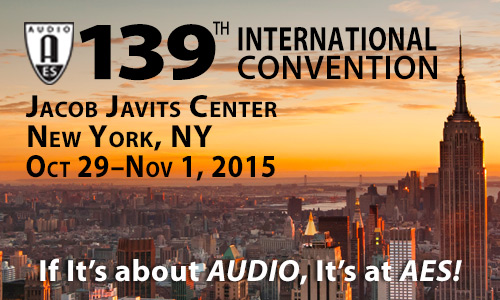
AES New York 2015
Engineering Brief EB4
EB4 - Listening, Hearing, & Production
Friday, October 30, 5:30 pm — 6:45 pm (Room 1A07)
Chair:
Bruno Fazenda, University of Salford - Salford, Greater Manchester, UK
EB4-1 Why Do My Ears Hurt after a Show (And What Can I Do to Prevent It)—Dennis Rauschmayer, REVx Technologies/REV33 - Austin, TX, USA
In this brief we review the traditional methods of preventing ear fatigue, short-term ear damage, and long term ear damage. A new method to prevent ear fatigue, focused on performing musicians is then presented. This method, which reduces noise and distortion in the artist’s mix, is discussed. Qualitative and quantitative results from a series of trials and experiments is presented. Qualitative results from artist feedback indicate less ear fatigue, less ringing in the ears, and a better ability to have normal conversations after a performance when noise and distortion in their mix is reduced. Quantitative results are consistent with the qualitative results and show a reduction in the change in otoacoustic emissions measured for a set of musicians when noise and distortion are reduced. The result of the study suggests that there is an important new tool for musicians to use to combat ear fatigue and short term hearing loss.
Engineering Brief 213 (Download now)
EB4-2 Classical Recording with Custom Equipment in South Brazil—Marcelo Johann, UFRGS - Porto Alegre, RS, Brazil; Andrei Yefinczuk, UFRGS - Porto Alegre, Brazil; Marcio Chiaramonte, Meber Metais - Bento Gonçalves, Brazil; Hique Gomez, Instituto Marcello Sfoggia - Porto Alegre, Brasil
This paper describes the process developed by Marcello Sfoggia for recording acoustic and classical music in south of Brazil, making intensive use of custom equipment. Sfoggia spent most of his lifetime building dedicated circuits to optimize sound reproduction and recording. He took the task of registering major performances in the city of Porto Alegre, using his home-developed equipment, what became a reference process. We describe the system employed for both sound capture and mixdown. Key components of the signal flow include preamplifiers with precision op-amps, short signal paths, modified A/D/A converters and the mixing desk with pure vacuum tube circuitry. Finally, we address our current efforts to continue his activities and improve upon his system with updated circuits and techniques.
Engineering Brief 214 (Download now)
EB4-3 Techniques For Mixing Sample-Based Music—Paul "Willie Green" Womack, Willie Green Music - Brooklyn, NY, USA
Samples are a great way to add impact, vibe, and texture to a song and can often be the primary component of a new work. From a production standpoint, audio that is already mixed and mastered can add to a producer’s sonic palette. From a mixing perspective, however, these same bonuses also provide a number of challenges. Looking more closely at each of the common issues an engineer often faces with sample-based music, I will illustrate techniques that can enable an engineer to better manipulate a sample, allowing it to sit more naturally inside the mix as a whole.
Engineering Brief 215 (Download now)
EB4-4 Case Studies of Inflatable Low- and Mid-Frequency Sound Absorption Technology—Niels Adelman-Larsen, Flex Acoustics - Copenhagen, Denmark
Surveys among professional musicians and sound engineers reveal that a long reverberation time at low frequencies in halls during concerts of reinforced music is a common cause for an unacceptable sounding event. Mid- and high-frequency sound is seldom a reason for lack of clarity and definition due to a 6 times higher absorption by audience compared to low frequencies, and a higher directivity of speakers at these frequencies. Lower frequency sounds are, within the genre of popular music however, rhythmically very active and loud, and a long reverberation leads to a situation where the various notes and sounds cannot be clearly distinguished. This reverberant bass sound rumble often partially masks even the direct higher pitched sounds. A new technology of inflated, thin plastic membranes seems to solve this challenge of needed low-frequency control. It is equally suitable for multipurpose halls that need to adjust their acoustics by the push of a button and for halls and arenas that only occasionally present amplified music and need to be treated just for the event. This paper presents the authors’ research as well as the technology showing applications in dissimilarly sized venues, including before and after measurements of reverberation time versus frequency.
Engineering Brief 216 (Download now)
EB4-5 Advanced Technical Ear Training: Development of an Innovative Set of Exercises for Audio Engineers—Denis Martin, McGill University - Montreal, QC, Canada; CIRMMT - Montreal, QC, Canada; George Massenburg, Schulich School of Music, McGill University - Montreal, Quebec, Canada; Centre for Interdisciplinary Research in Music Media and Technology (CIRMMT) - Montreal, Quebec, Canada
There are currently many automated software solutions to tackle the issue of timbral/EQ training for audio engineers but only limited offerings for developing other skills needed in the production process. We have developed and implemented a set of matching exercises in Pro Tools that fill this need. Presented with a reference track, users are trained in matching inter-instrument levels/gain, lead instrument volume automation, instrument spatial positioning/panning, reverberation level, and compression settings on a lead element within a full mix. The goal of these exercises is to refine the listener’s degree of perception along these production parameters and to train the listener to associate these perceived variations to objective parameters they can control. We also discuss possible future directions for exercises.
Engineering Brief 217 (Download now)

